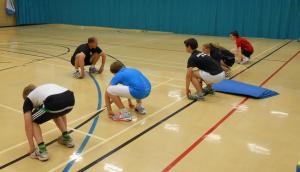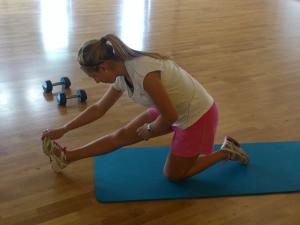Are girls more flexible than boys?
Are girls naturally more flexible, or is it training?

Gorilla stretch
We often get asked this question when training our athletes. At Excelsior mobility is one of the four pillars that form your structural integrity (posture, balance, control being the others).
Duncan writes below about some of his thoughts on mobility training and how it works with the boys and girls he trains.
What affects mobility?
As the leading question implies gender can have an effect, but there are other influences too. Gummerson (1) splits these into internal and external influences:
Internal influences include: type of joint, elasticity of muscle tissue, tendons, ligaments and skin, ability of the muscle to relax.
External influences include: temperature, time of day, age, commitment to achieving greater mobility.
How gender affects mobility
When I look at the players I work with, in general the girls are more flexible than the boys when stretching. I think there are three reasons for this:
- Genetic
- Sports played
- Psychological
Genetics: The female body shape has specific influences on mobility.
- The width of the pelvis is wider and more circular giving a greater range of motion.
- This creates a greater angle between the femur and tibia, known as the Q angle, this can cause many problems if not strengthened correctly.
- Females shoulders are narrower than males making them weaker in push and pull activities.
- A female’s weight distribution is also different to males, their weight is distributed lower around hips/thighs which gives them a lower centre of gravity giving a stability advantage. I believe this has a psychological affect as females will have less problems balancing during stretching.
- Hormones can have a large influence too. Females have greater oestrogen levels and lower testosterone levels.
- Oestrogen is involved in the menstrual cycle which causes females to have a greater laxity especially in their hips during this time.
- Testosterone increases muscle and bone size, which is why males are larger than females. Increased mass can cause mobility restrictions.
Sports played
Sports have been separated by gender, an example shown below. 30 years ago this would not affect young athletes as much due to the nature of physical education in school, however with current time restraints and syllabuses young athletes spend more time in classrooms looking at the theoretical rather than applied.
|
Gender |
Sport |
|
Male |
Rugby, football, athletics, hockey, cricket |
|
Female |
Netball, hockey, athletics |
Above is an example of the sports children compete in at independent schools.
There are some differences and it is slowly becoming more acceptable for girls to play football. The Olympics has possibly helped this with Team GB winning medals in sports previously classed as gender specific; boxing, judo and gymnastics for example.

Scorpion stretch
Multi sport athletes seem to be more mobile than their single sport sport peers.
For example, tennis players can become one side dominant and have limited hip mobility due to movements on court, compare this to a tennis player who also does karate, you will see a more symmetrical body shape.
It is important to understand that a young tennis player who only plays tennis is likely to suffer mobility issues whether they are male or female due to the asymmetrical nature of the sport (see picture above of limited hip and back mobility).
Psychological
 I believe their has been a stigma connected with stretching which has meant boys have not stretched. Pilates and Yoga were first thought of as female dominated classes, now with elite athletes talking about using them it has become more acceptable for males to try them.
I believe their has been a stigma connected with stretching which has meant boys have not stretched. Pilates and Yoga were first thought of as female dominated classes, now with elite athletes talking about using them it has become more acceptable for males to try them.
Working with mixed groups I can see that girls enjoy stretching more than boys which means they work on it more and so become more flexible than their peers.
Personally and from experience boys tend to have a shorter attention span, struggling to concentrate long enough to improve stretching, they would prefer to be playing games. Their is a greater impatience too, boys can find it harder to balance and therefore stretch effectively, this can mean minimal improvements but is where programme design comes in.
How can I improve my flexibility?
I have noticed more children becoming injured younger due to overuse and poor movement patterns compared to when I was younger, by concentrating on a single sport our bodies make compensations for weak movements which leads to the overuse injuries.
By adjusting programmes we can develop better athletes, we need to:
- Include regular strength work, that works on movement efficiency. If you train through a short range with poor technique, stretching afterwards will be ineffective.
- Include appropriate warm ups & cool downs, mobility can be developed and retained here.
- Give athletes the knowledge to stretch at home, they need to be coached on technique so they know how a stretch should feel rather than go through the motions (see video below)
Duncan Buckmaster
If you are interested in learning more, then either train at our Athletic Development Club in Devon or
Watch our You Tube channel for more ideas.
1 Mobility training for martial arts, Tony Gummerson

Me and my friends in school are much more flexible than the boys for example my friends and I showed them a backbend cause we know how to do it.And a boy named Torell he said he knew how to do it but when he showed us he went on his knees and pretended to do one and then me and my friends said ‘oh please thats not even close to a backbend’
#$wag
[…] Are girls more flexible than boys? […]
So girls are more flexible than boys?
Women are more flexible than men because they stretch more. Men get bored stretching and think it isn’t macho.
If they did some mobility work, or got off machine weights, then they would be more flexible.
Male gymnasts and weight lifters are very flexible because they move through a big range.